-
 Bitcoin
Bitcoin $107,631.9817
-1.73% -
 Ethereum
Ethereum $2,739.1787
-4.61% -
 Tether USDt
Tether USDt $1.0000
-0.01% -
 XRP
XRP $2.2427
-3.30% -
 BNB
BNB $664.0527
-0.73% -
 Solana
Solana $158.0902
-5.38% -
 USDC
USDC $0.9998
-0.01% -
 Dogecoin
Dogecoin $0.1876
-7.78% -
 TRON
TRON $0.2753
-3.21% -
 Cardano
Cardano $0.6820
-5.55% -
 Hyperliquid
Hyperliquid $43.0171
-0.38% -
 Sui
Sui $3.3308
-4.87% -
 Chainlink
Chainlink $14.3431
-7.89% -
 Avalanche
Avalanche $21.0266
-6.48% -
 Bitcoin Cash
Bitcoin Cash $437.7657
-1.56% -
 Stellar
Stellar $0.2746
-2.52% -
 UNUS SED LEO
UNUS SED LEO $8.8665
-1.96% -
 Toncoin
Toncoin $3.1885
-3.37% -
 Shiba Inu
Shiba Inu $0.0...01260
-6.84% -
 Hedera
Hedera $0.1686
-4.93% -
 Litecoin
Litecoin $88.8406
-5.16% -
 Polkadot
Polkadot $4.0542
-6.28% -
 Monero
Monero $322.5806
-4.20% -
 Ethena USDe
Ethena USDe $1.0004
-0.02% -
 Bitget Token
Bitget Token $4.7089
-3.10% -
 Dai
Dai $0.9998
-0.01% -
 Pepe
Pepe $0.0...01206
-9.06% -
 Uniswap
Uniswap $7.8694
-5.20% -
 Pi
Pi $0.6232
-2.68% -
 Aave
Aave $301.3815
-3.83%
How long can KDJ rise after being overbought? Special judgment method when the indicator is blunted
The KDJ indicator, popular in crypto trading, signals potential price reversals but its overbought duration varies, requiring traders to use additional indicators for confirmation.
Jun 10, 2025 at 11:15 am
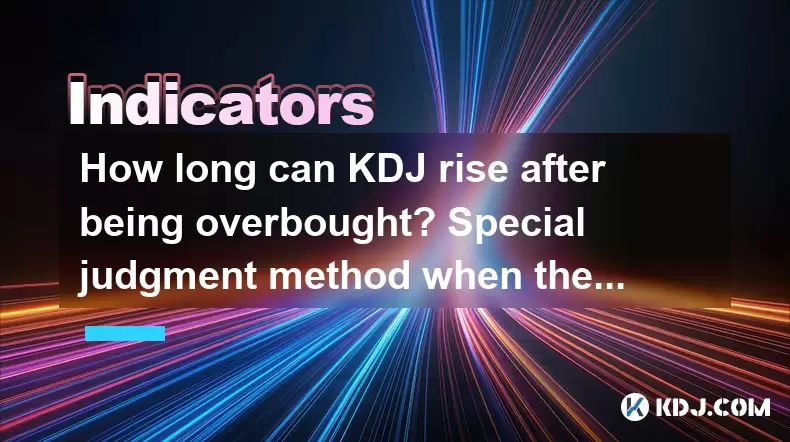
The KDJ indicator is a widely used technical analysis tool in the cryptocurrency trading community, designed to predict price reversals in the market. It is particularly popular among traders who aim to capitalize on short-term price movements. When the KDJ indicator enters an overbought state, it often signals that a potential price correction or reversal may be imminent. However, the duration for which the KDJ can remain overbought before a significant price change occurs is not fixed and can vary greatly depending on market conditions and the specific cryptocurrency being traded.
Understanding the KDJ Indicator
The KDJ indicator is composed of three lines: the K line, the D line, and the J line. The K and D lines are calculated based on the highest high, lowest low, and the closing price over a specific period. The J line is a more sensitive indicator, calculated as three times the difference between the K and D lines minus the D line. When the KDJ lines move above a certain threshold, typically 80, the market is considered overbought, suggesting that the asset may be due for a price correction.
Duration of Overbought Conditions
The length of time that the KDJ can remain in an overbought state varies widely. In some cases, the overbought condition may persist for just a few hours or days, while in other instances, it can last for weeks. Several factors influence this duration, including market sentiment, trading volume, and the presence of significant news or events that could impact the cryptocurrency's price.
Special Judgment Method When the Indicator is Blunted
When the KDJ indicator appears to be blunted or less responsive to price movements, traders need to employ special judgment methods to interpret the signals accurately. One effective approach is to combine the KDJ with other technical indicators, such as the Relative Strength Index (RSI) or the Moving Average Convergence Divergence (MACD). By cross-referencing signals from multiple indicators, traders can gain a more comprehensive understanding of market conditions and make more informed trading decisions.
Combining KDJ with Other Indicators
To enhance the reliability of the KDJ indicator when it is blunted, traders often look to other tools for confirmation. For instance, if the RSI also indicates an overbought condition, it strengthens the case for a potential price correction. Similarly, if the MACD shows bearish divergence, it may signal that a downward price movement is more likely. By integrating these indicators, traders can better navigate periods when the KDJ appears less reliable.
Practical Application in Cryptocurrency Trading
In the context of cryptocurrency trading, applying the KDJ indicator effectively requires a nuanced approach. Traders should monitor the KDJ in conjunction with price charts and other technical indicators to identify potential entry and exit points. For example, if the KDJ enters an overbought state and the price of a cryptocurrency is nearing a significant resistance level, it may be a good opportunity to sell or short the asset. Conversely, if the KDJ moves into an oversold state near a strong support level, it could be a signal to buy.
Case Study: Bitcoin and KDJ
Let's consider a practical example with Bitcoin. Suppose the KDJ indicator for Bitcoin enters an overbought state, with all three lines above the 80 threshold. If this condition persists for several days and the price of Bitcoin continues to rise without any significant pullback, traders might start to question the reliability of the KDJ signal. In such a scenario, it would be prudent to check other indicators like the RSI or MACD for additional insights. If these indicators also suggest overbought conditions, it might reinforce the expectation of a forthcoming price correction.
Trading Strategies Based on KDJ
Developing a trading strategy that incorporates the KDJ indicator involves setting clear rules for entry and exit points. For instance, a trader might decide to sell a portion of their holdings when the KDJ enters an overbought state and the price touches a resistance level. Conversely, they might buy when the KDJ moves into an oversold state and the price approaches a support level. Additionally, using stop-loss orders can help manage risk and protect against unexpected market movements.
Monitoring and Adjusting to Market Conditions
The cryptocurrency market is highly volatile, and conditions can change rapidly. Traders need to stay vigilant and continuously monitor their chosen indicators, including the KDJ, to adjust their strategies accordingly. If the market enters a prolonged bullish trend, the KDJ may remain overbought for an extended period. In such cases, traders might need to adjust their expectations and consider using longer time frames for their analysis to better capture the overall market trend.
Frequently Asked Questions
Q: Can the KDJ indicator be used effectively in all market conditions?
A: While the KDJ indicator is a powerful tool for identifying overbought and oversold conditions, its effectiveness can vary depending on market volatility and trends. In highly volatile markets, the KDJ may generate more false signals, necessitating the use of additional indicators for confirmation.
Q: How often should traders check the KDJ indicator?
A: The frequency of checking the KDJ indicator depends on the trader's strategy and time frame. For short-term traders, checking the indicator multiple times a day may be necessary, while long-term traders might only need to review it on a daily or weekly basis.
Q: Are there specific cryptocurrencies for which the KDJ indicator works better?
A: The effectiveness of the KDJ indicator can vary across different cryptocurrencies due to differences in market liquidity and volatility. Generally, it tends to work well with highly liquid assets like Bitcoin and Ethereum, but traders should always test the indicator on historical data for the specific cryptocurrency they are trading.
Q: Can the KDJ indicator be used alone for trading decisions?
A: While the KDJ indicator can provide valuable insights, it is generally recommended to use it in conjunction with other technical analysis tools. Relying solely on the KDJ may lead to false signals, especially during periods of high market volatility or when the indicator is blunted.
Disclaimer:info@kdj.com
The information provided is not trading advice. kdj.com does not assume any responsibility for any investments made based on the information provided in this article. Cryptocurrencies are highly volatile and it is highly recommended that you invest with caution after thorough research!
If you believe that the content used on this website infringes your copyright, please contact us immediately (info@kdj.com) and we will delete it promptly.
- The Bitcoin Treasury Strategy That's Reanimating Zombie Companies
- 2025-06-13 03:00:12
- BlockDAG (BDAG) Could Be the Next Biggest Altcoin as NBA Courtside Exposure Teases a Possible 2x Rally
- 2025-06-13 03:00:12
- Tether (USDT) Buys 32% Stake in Canada's Public Gold Royalty Firm Elemental Altus Royalties
- 2025-06-13 02:55:12
- Troller Cat Surges Past $225K in Presale as Dogwifhat Dips and FLOKI Gains
- 2025-06-13 02:55:12
- The graph (GRT), a key player in blockchain data indexing, has not seen a price pump yet.
- 2025-06-13 02:50:13
- Is This the Season Where Meme Coins Rewrite Crypto History Again?
- 2025-06-13 02:50:13
Related knowledge
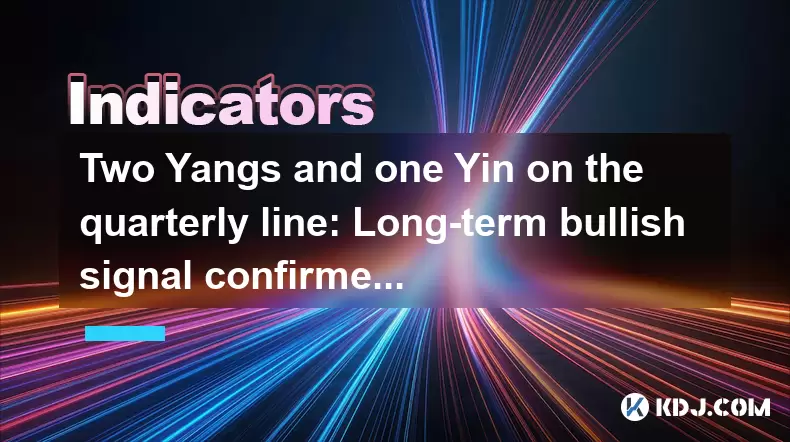
Two Yangs and one Yin on the quarterly line: Long-term bullish signal confirmed?
Jun 12,2025 at 07:00am
Understanding the 'Two Yangs and One Yin' Candlestick PatternIn technical analysis, candlestick patterns play a pivotal role in identifying potential market reversals or continuations. The 'Two Yangs and One Yin' pattern is one such formation that traders often observe on longer timeframes like the quarterly chart. This pattern consists of two bullish (...
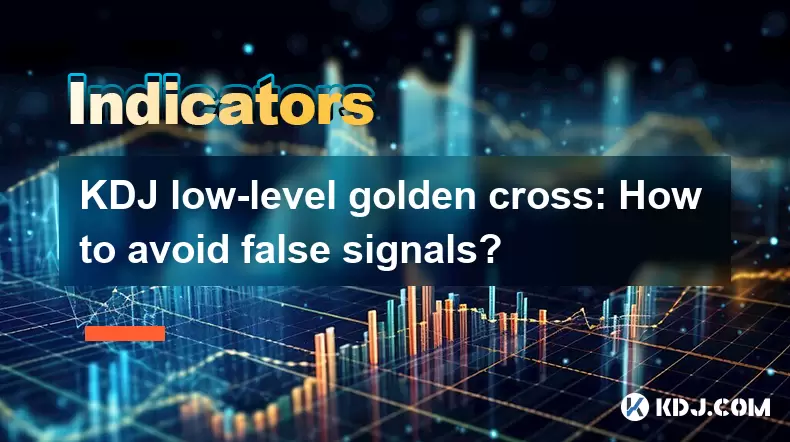
KDJ low-level golden cross: How to avoid false signals?
Jun 12,2025 at 08:21am
Understanding the KDJ IndicatorThe KDJ indicator, also known as the stochastic oscillator, is a momentum-based technical analysis tool widely used in cryptocurrency trading. It consists of three lines: the %K line (fast stochastic), the %D line (slow stochastic), and the %J line (divergence value). These lines oscillate between 0 and 100, helping trader...

Bottom-up volume stagnation: Is it accumulation or heavy selling pressure?
Jun 12,2025 at 01:42pm
What Is Bottom-Up Volume Stagnation?Bottom-up volume stagnation refers to a specific pattern observed in cryptocurrency trading charts where the price of an asset moves sideways or slightly downward, and trading volume remains consistently low over an extended period. This phenomenon is often seen after a sharp price drop or during a prolonged bear mark...
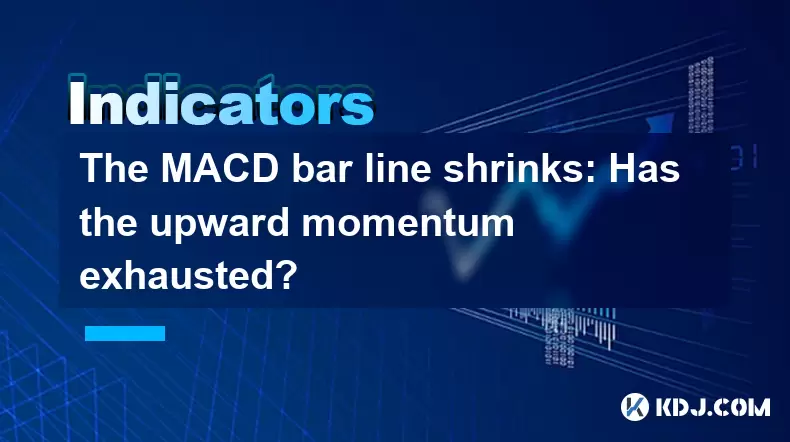
The MACD bar line shrinks: Has the upward momentum exhausted?
Jun 12,2025 at 12:49am
Understanding the MACD Bar LineThe Moving Average Convergence Divergence (MACD) is a widely used technical indicator in cryptocurrency trading. It consists of three main components: the MACD line, the signal line, and the MACD histogram (also known as the bar line). The MACD bar line represents the difference between the MACD line and the signal line. W...

The chip peak moves up: Is the main force quietly shipping?
Jun 12,2025 at 01:01am
Understanding the Chip Peak Movement in Cryptocurrency MiningIn recent years, the chip peak movement has become a critical topic within the cryptocurrency mining community. This phrase typically refers to the point at which mining hardware reaches its maximum efficiency and output capacity. When this peak shifts upward, it often signals changes in the s...
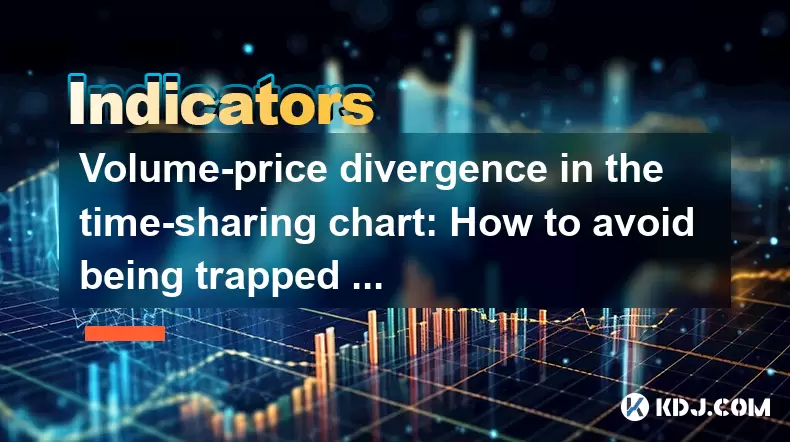
Volume-price divergence in the time-sharing chart: How to avoid being trapped on the same day?
Jun 12,2025 at 07:28pm
Understanding Volume-Price Divergence in Cryptocurrency TradingVolume-price divergence is a critical concept in technical analysis, especially within the fast-moving world of cryptocurrency trading. It refers to a situation where price movement and trading volume move in opposite directions. For instance, if the price of a cryptocurrency is rising while...

Two Yangs and one Yin on the quarterly line: Long-term bullish signal confirmed?
Jun 12,2025 at 07:00am
Understanding the 'Two Yangs and One Yin' Candlestick PatternIn technical analysis, candlestick patterns play a pivotal role in identifying potential market reversals or continuations. The 'Two Yangs and One Yin' pattern is one such formation that traders often observe on longer timeframes like the quarterly chart. This pattern consists of two bullish (...

KDJ low-level golden cross: How to avoid false signals?
Jun 12,2025 at 08:21am
Understanding the KDJ IndicatorThe KDJ indicator, also known as the stochastic oscillator, is a momentum-based technical analysis tool widely used in cryptocurrency trading. It consists of three lines: the %K line (fast stochastic), the %D line (slow stochastic), and the %J line (divergence value). These lines oscillate between 0 and 100, helping trader...

Bottom-up volume stagnation: Is it accumulation or heavy selling pressure?
Jun 12,2025 at 01:42pm
What Is Bottom-Up Volume Stagnation?Bottom-up volume stagnation refers to a specific pattern observed in cryptocurrency trading charts where the price of an asset moves sideways or slightly downward, and trading volume remains consistently low over an extended period. This phenomenon is often seen after a sharp price drop or during a prolonged bear mark...

The MACD bar line shrinks: Has the upward momentum exhausted?
Jun 12,2025 at 12:49am
Understanding the MACD Bar LineThe Moving Average Convergence Divergence (MACD) is a widely used technical indicator in cryptocurrency trading. It consists of three main components: the MACD line, the signal line, and the MACD histogram (also known as the bar line). The MACD bar line represents the difference between the MACD line and the signal line. W...

The chip peak moves up: Is the main force quietly shipping?
Jun 12,2025 at 01:01am
Understanding the Chip Peak Movement in Cryptocurrency MiningIn recent years, the chip peak movement has become a critical topic within the cryptocurrency mining community. This phrase typically refers to the point at which mining hardware reaches its maximum efficiency and output capacity. When this peak shifts upward, it often signals changes in the s...

Volume-price divergence in the time-sharing chart: How to avoid being trapped on the same day?
Jun 12,2025 at 07:28pm
Understanding Volume-Price Divergence in Cryptocurrency TradingVolume-price divergence is a critical concept in technical analysis, especially within the fast-moving world of cryptocurrency trading. It refers to a situation where price movement and trading volume move in opposite directions. For instance, if the price of a cryptocurrency is rising while...
See all articles

























































































